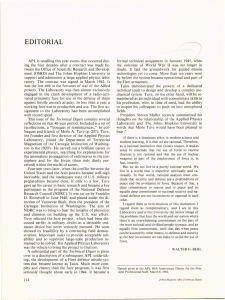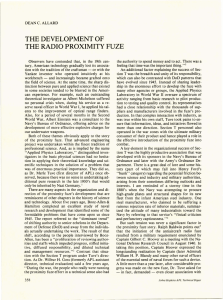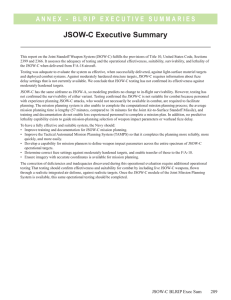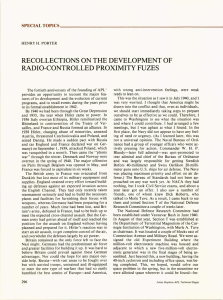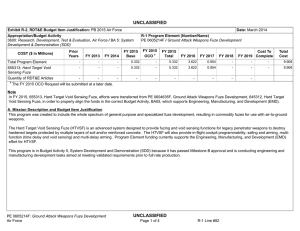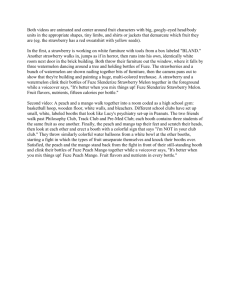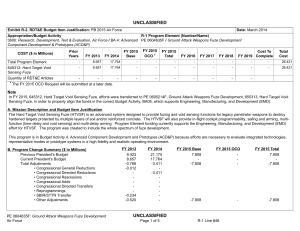APL VT FUZE and the
advertisement
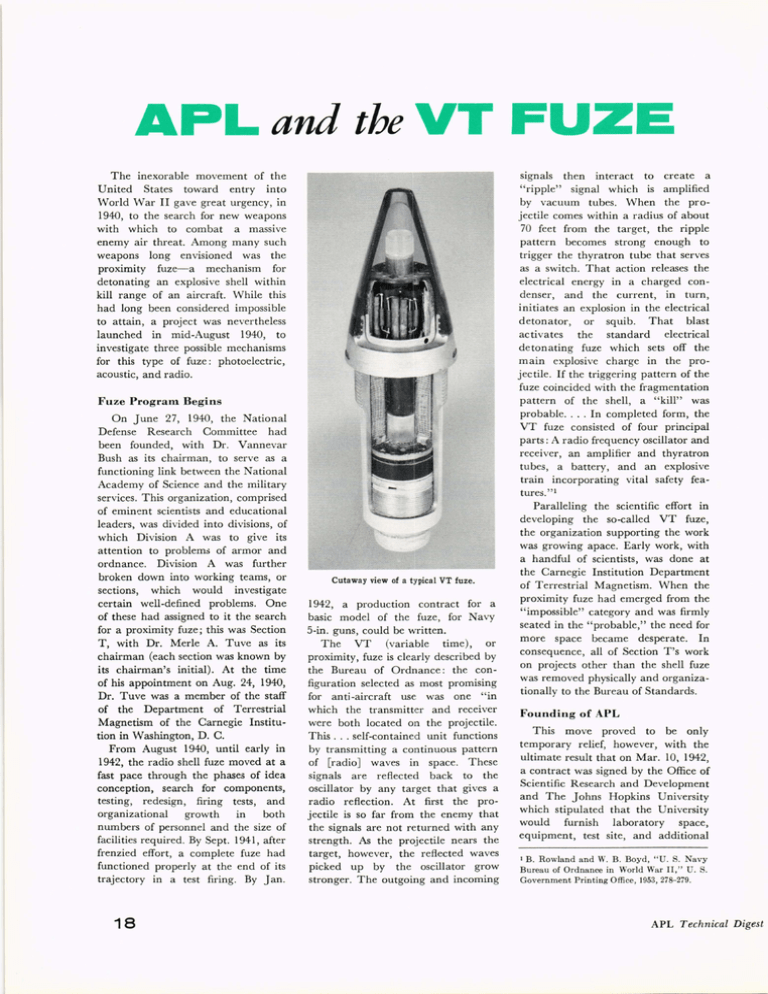
APL and the VT FUZE The inexorable movement of the United States toward entry into World War II gave great urgency, in 1940, to the search for new weapons with which to combat a massive enemy air threat. Among many such weapons long envisioned was the proximity fuze- a mechanism for detonating an explosive shell within kill range of an aircraft. While this had long been considered impossible to attain, a project was nevertheless launched in mid-August 1940, to investigate three possible mechanisms for this type of fuze: photoelectric, acoustic, and radio. Fuze Program Begins On June 27, 1940, the National Defense Research Committee had been founded, with Dr. Vannevar Bush as its chairman, to serve as a functioning link between the National Academy of Science and the military services. This organization, comprised of eminent scientists and educational leaders, was divided into divisions, of which Division A was to give its attention to problem,; of armor and ordnance. Division A was further broken down into working teams, or sections, which would investigate certain well-defined problems. One of these had assigned to it the search for a proximity fuze; this was Section T, with Dr. Merle A. Tuve as its chairman (each section was known by its chairman's initial). At the time of his appointment on Aug. 24, 1940, Dr. Tuve was a member of the staff of the Department of Terrestrial Magnetism of the Carnegie Institution in Washington, D. C. From August 1940, until early in 1942, the radio shell fuze moved at a fast pace through the phases of idea conception, search for components, testing, redesign, firing tests, and organizational growth in both numbers of personnel and the size of facilities required. By Sept. 1941, after frenzied effort, a complete fuze had functioned properly at the end of its trajectory in a test firing. By Jan. 18 Cutaway view of a typical VT fuze. 1942, a production contract for a basic model of the fuze, for Navy 5-in. guns, could be written. The VT (variable time), or proximity, fuze is clearly described by the Bureau of Ordnance: the configuration selected as most promising for anti-aircraft use was one "in which the transmitter and receiver were both located on the projectile. This ... self-contained unit functions by transmitting a continuous pattern of [radio] waves in space. These signals are reflected back to the oscillator by any target that gives a radio reflection. At first the projectile is so far from the enemy that the signals are not returned with any strength. As the projectile nears the target, however, the reflected waves picked up by the oscillator grow stronger. The outgoing and incoming signals then interact to create a "ripple" signal which is amplified by vacuum tubes. When the projectile comes within a radius of about 70 feet from the target, the ripple pattern becomes strong enough to trigger the thyratron tube that serves as a switch. That action releases the electrical energy in a charged condenser, and the current, in turn, initiates an explosion in the electrical detonator, or squib. That blast activates the standard electrical detonating fuze which sets off the main explosive charge in the projectile. If the triggering pattern of the fuze coincided with the fragmentation pattern of the shell, a "kill" was probable .. . . In completed form, the VT fuze consisted of four principal parts: A radio frequency oscillator and receiver, an amplifier and thyratron tubes, a battery, and an explosive train incorporating vital safety features."l Paralleling the scientific effort in developing the so-called VT fuze, the organization supporting the work was growing apace. Early work, with a handful of scientists, was done at the Carnegie Institution Department of Terrestrial Magnetism. When the proximity fuze had emerged from the "impossible" category and was firmly seated in the "probable," the need for more space became desperate. In consequence, all of Section T's work on projects other than the shell fuze was removed physically and organizationally to the Bureau of Standards. Founding of APL This move proved to be only temporary relief, however, with the ultimate result that on Mar. 10, 1942, a contract was signed by the Office of Scientific Research and Development and The Johns Hopkins University which stipulated that the University would furnish laboratory space, equipment, test site, and additional 1 B. Rowland a nd W. B . Boyd, " U. S . N avy Bureau of Ordnance in World Wa r II, " U. S. Government Printing Office, 1953, 278-279 . APL Technical Digest personnel for furthering the VT fuze program. Dr. Tuve was to continue as head of the program, and overall administration was transferred to the OSRD. Dr. Tuve conceived the name "Applied Physics Laboratory" for the new organization operating under The Johns Hopkins University. With this brief background of the emergence of the VT fuze, we may now look in some detail at the vastness of the fuze program and at its impact on the unfolding drama of World War II*. The Johns Hopkins University entered upon its new responsibilities in a manner that gave promise of continued rapid progress in the development of the VT fuze. The President of the University appointed D. Luke Hopkins, member of the Board of Trustees, as the official representative of the University in all matters pertaining to APL. Mr. Hopkins stated that the University's purpose was "to see to it that the job progressed as smoothly, expeditiously, and efficiently as possible." The immediate task, of course, was to provide whatever was most needed to enable Section T's expanding program to be carried on effectively by the newly established Applied Physics Laboratory. The most important and most obvious requirement was additional personnel, but before new staff could be taken on, office and shop space adequate to accommodate them had to be acquired. In Silver Spring, Md., a sparsely settled cross-roads community at the time, a garage was found which, it appeared, would serve well for the present at least. Lease of this property, 861 7 to 8621 Georgia Ave., was arranged by the University to include not only the garage floor but also the second and third floors which were then occupied by a Social Security office. Many problems in adapting this building for use by the new Laboratory were overcome in a short time in spite of wartime limitations on materials and a tight labor market. The date of May 1, 1942, may be considered to mark the start of operations by APL • These historical notes are adapted from a history of the Applied Physics Laboratory being prepared under the direction of Rear Admiral M. R. Kelley, U . S. Navy (Ret.), assisted by staff members of APL . September-October 1962 at the Silver Spring location. The pressure for still more space continued, however. The rapidly expanding program seemed always to be exasperatingly ahead of the available physical facilities. In spite of a new building constructed just north of the garage, plus two new floors added to the original building, and a new connecting building, the space available for the Laboratory's work never seemed to be adequate. Needed facilities other than space to house the Laboratory included a new test field equipped with shelters for the personnel conducting tests, machine tools, instruments of various kinds, and other related equipment for laboratory and field use. A suitable site at Newtown Neck, Md., was leased and equipped for the safe conduct of vertical recovery firings. In spite of the many details that had to be taken care of in the relocation to Silver Spring, and the establishment of new administrative and communications channels, these tasks were accomplished in good time. The increase in staff from 100 in 1942 to 700 in 1944, under difficult conditions imposed by the need for complete secrecy, probably could never have been done under the restrictions that had existed before the entrance of The Johns Hopkins University in the role of contractoroperator for the OSRD. Problems of Design Recalling Dr. Tuve's statement that the success of this type of fuze was dependent on a great number of empirical factors, each dependent upon design of specific components, we can appreciate the need for the continuing program of testing. This included complete fuzes as well as tubes, oscillator circuits, detonators, explosive charges, and other components. Among the latter were the safety switches to prevent the shell from exploding either in the bore of a gun or within 0.3 to 0.5 sec after leaving the muzzle, and self-destruction mechanisms designed to explode the shell after it had passed beyond the target. The self-destruction feature was incorporated to prevent friendly units near the line-of-fire-extended from being endangered and enemy forces from having an opportunity to recover a dud. These components were tested under all conceivable operating conditions for all sizes of guns for which radio fuzes were to be produced, as well a3 for various changes in design intended to correct previous test failures . The search for glass rugged enough to withstand the shock of gunfire was constant, as it was for filaments, bridge wire, and wax. Even after the fuzes were in production, the test program objectives persisted in the quality control program. Illustrative of the experience that supported the need for the continual program of testing, even through quantity production, is Dr. Tuve's summarization of the development of rugged tubes: "Empirical factors enter in other ways than performance. For example, some design factors unpredictably limit production. We started five companies on the design and manufacture of rugged tubes, during 1940 to 1942. All designs were successfully rugged and made into successful fuzes. One failed to make them on anything but a laboratory basis, although large amounts of money were spent on pilot production lines during two years. The second has made rugged tubes continuously since early 1941. Maximum production ever reached was 4000 per day, with limited use of these tubes as substitutes. The third company started 1940 with fairly successful tubes, kept in production to early 1944, but could never exceed 20,000 per day because the design was not adapted to fast production .... The fourth company is now our primary supplier (260,000 per day). The fifth company made two million tubes, but characteristics were poor and fuzes variable. The tubes were set aside and production stopped early in 1943. (The sixth company was started and factory built but the factory was turned over to other work at our request.)"2 Mass Production Begins As the first of the production fuzes became available, the need for carrying the test program still farther was recognized. Until that time, Letter from M. A. Tuve to Lt. Col. C. F. Fell, Army Member of JPS Subcommittee; subject, "Confirmation of Important Features in Development and Production of VT Fuze," Sept. 28, 1944. 2 19 operation of the fuze test samples had been checked only by firings in which the radio waves that triggered the fuze were reflected from the water as the shell returned to the surface on the downward leg of its trajectory. A test that more accurately represented a shell approaching an aircraft was obviously needed. This was done for the first time at Parris Island in April 1942, when a full-scale aircraft target suspended from a balloon triggered the fuze . Later, chicken wire replicas of full-scale aircraft were suspended between two towers, and test fuzes were fired at them for determination of operational performance. Tests of production fuzes were then conducted against drone targets in Chesapeake Bay from the USS Cleveland. The three drones allotted to this series of tests were destroyed on the first day of firing by four proximity bursts. Because of this success, these realistic tests were considered a final " dress rehearsal" for the shell radio fuze before its first appearance in a theater of combat. From these results, specifications for a quantity production fuze were crystallized and production began. High Priority of Safety For the many models of the shell radio fuze that were manufactured and/or tested, exceptional care was taken to safeguard personnel against bursts in handling or in the bore of the gun, and to insure delay in postfire arming. The standard of safety set up as a requirement was no more than one muzzle burst in a million rounds. Not only in the design of the safety and arming element was such care taken , but also in the inspection and test program. An example will show the painstaking care used to preven t accidental bursts. The mercury unshorter switch was designed to prevent operation of the fuze during handling and loading and to insure that the shell could not be exploded until it had traveled a certain distance from the muzzle. It was cylindrical in shape, slightly over 0.25 in. in diameter, and about 0.4 in. long. Inside an outer chamber or sump, which was empty prior to high-speed spin of ·the projectile, was an inner chamber filled with mercury. In this location the mercury maintained an electric short in the cannon-primer 20 circuit so that it could not be fired. The wall of the inner chamber was a diaphragm of relatively porous material through which the mercury could pass under centrifugal force generated by the post-firing spin of the projectile, thereby removing the short in the primer circuit. The purest mercury obtainable commercially was procured for this use, but it was nevertheless subjected to additional distillation before it was considered to have the required purity. Selected samples of the thous ands of switches manufactured daily were then spun at a rate to produce the centrifugal force resulting from the proj ectile spin after firing. The time required for the mercury to pass through the diaphragm was accurately d etermined and, for acceptance, had to lie within specified limits. Rough handling tests of the switches followed, with each checked by X-ray to insure that it met the prescribed standards. Under a regime of such supervision and testing it is easy to see why safety provisions proved so successful. Military Demands In the spring of 1941 , priontles had been established to meet requirements of the armed forces in the following order : U. S. Navy, British Navy, U. S. Army, and British Army. Because of the optimism that had grown in the Section T program, the U. S. Joint Chiefs of Staff considered the matter of time and place of introducing the fuze into the various areas of combat operations. The above priorities reflected the viewpoint of the Joint Chiefs in their concern lest the fuze fall into enemy hands shortly after its initial use in combat. This would have made it possible for the Axis powers to develop counter-measures to reduce the effectiveness of the fuze and/or to develop their own versions of the fuze. If either had resulted, the advantage to the Allies of sole possession and use of this new weapon would have been substantially reduced. Aside from the fact that the U. S. Navy had assigned the highest priority to the shell radio fuze and was supporting its development in every possible way, there was, of course, the obvious fact that use of the fuze by naval forces afloat would greatly reduce the likelihood of its being recovered by t he enemy. Colonel H. S. Morton and Drs. L. R. Hafstad and M. A. Tuve (1. to r.) examine early VT fuzes for use in Europe. With quantity production of a fuze for the Navy's 5-in. guns getting underway in the fall of 1942, a very urgent problem which had already been recognized came to the fore. This was the need for appropriate steps to be taken to indoctrinate the combat forces in its proper handling and use. A necessary follow-on of utmost importance was to build up their confidence in its capabilities so that they would overlook no opportunity to use it in action. Once they had seen results, it was felt by those who were engaged in the development and test program, and by those of the Navy who had followed this program closely, that the users would be enthusiastic. The proximity fuze did not present the kind of breakthrough that would at once demand a change in either the strategy or tactics of the allied forces. Rather, it gave promise that the strategic plans already in effect, and the tactics being employed, could be confidently adhered to with the exp ectation of a decisive victory. Without the new fuze, on the other hand, revision of both strategy and tactics at the appropriate levels might be forced upon the Allies because of their losses to attacking aircraft and the German V born bs. Experienced officers in the Navy Bureau of Ordnance who had close contact with the fuze program were quick to see that indoctrination of the fighting forces in its capabilities and use was of utmost importance if the full benefits of this new weapon were APL Technical Digest to be reaped quickly. And Dr. Tuve's instruction on the subject of Section T's moral responsibility would clearly indicate what importance he attached to such indoctrination. The Fuze Goes into Action Since the Combined Chiefs of Staff felt strongly that the fuze should not be used where a dud might be recovered on the ground, the South Pacific, where Japanese land-based aircraft were a constant and serious menace, seemed the area of first importance. First deliveries of the new fuzes, then, were to be made to ships in that area having the 5-in . guns for which the earliest production fuzes were designed. During October 1942, 500 fuzes for shipboard use were produced each day and shipped immediately to the Naval Ammunition Depot, Mare Island, where they were inserted in the fuze cavities of 5-in. shells. Of each day's consignment, 10 % were withdrawn and flown back to the Naval Proving Ground, Dahlgren, Va., for test. When 5000 proximity-fuzed projectiles had accumulated, Commander W. S. Parsons, Special Assistant to the Director, OSRD, went to Mare Island to supervise loading of the shells for air transportation to Pearl Harbor. He then flew to Hawaii, leaving the ammunition in the care of three scientists from APL specifically commissioned for this duty: Lieutenants N. E. Dilley, R. P. Petersen, and J. A. Van Allen . made such an important contribution to total Allied victory. The Problem. of the Fuze in Europe In addition to the three APL scientists commissioned to assist in introducing the new fuze to Pacific Fleet units, two other APL staff members had been selected for the same duties in the Atlantic and Mediterranean areas: Lieutenants E. R. Chatham and R. Morison. But introduction of the fuze in these areas was intentionally delayed about six months for several important reasons. First, the waters in which the Pacific Fleet units were operating were of appreciably broader expanse and were much less likely to be monitored by high-performance radio countermeasures and direction-finding equipment at strategic points on land. It was thought that the Germans would be much more likely than the Japanese to have such equipment, and at this stage of the war would no doubt have the vital sea areas well monitored. Another factor was that injection of the fuze into combat situations on a broad scale would require time in which to check out battery personnel, tactics, fuze performance under shipboard conditions, and indications of enemy jamming. Early experience gained in the Pacific could be used to modify defects in the fuze, develop the most effective tactics for its use, and check out logistics and handling problems. Successful introduction of the fuze First Strike-Pacific Theater At Pearl Harbor the shells were loaded into the aircraft tender USS Wright for transshipment to Noumea, New Caledonia, where Commander Parsons reported to Admiral Halsey. Three ships of the Third Fleet received portions of this first shipmentUSS Enterprise, USS Saratoga, and USS Helena- and indoctrination of their personnel commenced immediately. There was a period of relative inactivity in the Third Fleet area at the time, extending into the early months of 1943, an excellent time for indoctrination but giving little opportunity for battle test of the new fuze. On Jan. 5, 1943, however, a Japanese plane was destroyed by a proximity fuze, the first of a long record of encouraging successes that September-October 1962 The VT fuze on Iwo Jima in 1945. into the Atlantic and Mediterranean areas would be greatly aided by this experience, especially if its safety and performance record proved to be all that was desired. The Navy'S indoctrination team arrived in the Mediterranean in the closing days of the North African campaign and had completed introductory instruction for all concerned by the time the Sicilian operations got under way. Confidence in the new fuze was more easily built up because action reports from the Pacific were available to bear out the claims of the instruction teams. On the Army side, a well-planned program of indoctrination was put into effect. Colonel H. S. Morton, assigned as the Army's liaison officer to Sections T and E, and later to APL, was a key figure in this program. As early as Sept. 1942, the Army had asked for 1,000,000 proximity fuzes. Accompanied by transfer of the necessary funds to support the stated requirement, this indication of faith in the project was of vital importance to its continued progress, especially when the Army's primary effort and financial support had been directed to the photoelectric fuze project of Section E. Colonel Morton was sent to Europe where, from the beginning, he talked about the proximity fuze to any and all officers who would listen to him. Those in the highest command echelons, as well as officers in the lower echelons who would have the responsibility for using the fuzes in battle, were given thorough briefings on it and on the advantages it offered for use against both ground and air targets. Some of them, of course, already knew about the fuze, and some undoubtedly felt that this was a new "gimmick" that might be worth a try. Colonel Morton outlined the most effective methods of employment over different kinds of terrain and against low- and high-altitude air attack; also, the dangers involved for U. S. observation aircraft engaged in spotting artillery fire. F or the field artillerymen especially, the fuze promized to be an ideal solution to the problem of putting bursts at an optimum altitude above the ground when used against personnel and other battlefield targets. 21 A pattern of bursts of VT -fuzed anti-personnel shells over a battlefield in France during World War II. APL Keeps Pace with Changing Demands As a build-up for indoctrinating the fighting forces in use of the fuze, Dr. Tuve had seen early the desirability of instructing Army and Navy personnel in the design , inspection, handling, and functioning of proximity fuzes. This was in line with his views that the fuze must be closely followed by APL right to the field of battle. The Ordnance Department of the Army, fully appreciating the importance of a program to introduce the fuzes to appropriate Army units, selected 200 officers and men for training at APL and at the Bureau of Standards. These men participated in certain phases of the development work at the laboratories and in field testing, as well as in those methods of handling the fuzes that were pertinent to battlefield operations. The Navy also selected officers and men for advanced training in the shell radio fuze at APL. The trainees of both Services contributed in no small degree to the success of the entire program. With the start of quantity production in the fall of 1942, many complications arose, resulting in part from the priorities established by the Combined Chiefs of Staff. Many diverse requirements had to be satisfied within a time scale that would permit each of the military forces to bring its full weight to bear in execution of the overall strategic plan. The basic design of the proximity fuze for the Navy'S 5-in. guns could not, merely by a process of rescaling the dimensions, be readily adapted for use in the vario"lis types of guns in the other three military organizations. There were differences in caliber, muzzle velocity, rate of projectile spin, 22 handling and loading equipment, and of course in the basic missions for which each was designed. A m easure of these complexities is obtained when we note that there were eight models of the shell radio fuze required for the U. S. Navy, four for the British Navy, twelve for the U. S. Army, and six models for the British Army. The modifications that were needed introduced some fears that a modified fuz e might prove unsafe in its handling, loading, and firing cycle; hence, the seemingiy endless program of testing this one feature continued to demand the greatest care. As if these problems were not complicated enough, many planners and operators in the using services were changing their minds at frequent and unpredictable intervals concerning the number of fuzes of each model they would need. The Applied Physics Laboratory was not, of course, in the business of producing these different types of fuze. However, APL had the principal responsibility for the design adaptations, a responsibility which certainly could not be dropped at the moment the modified fuzes were put into production. Without full cooperation of the many industrial contractors under Section T, this responsibility could not have been discharged. The extent of the industrial participation in the program has been succinctly summarized in the official history of the OSRD as follows: "In the months just preceding V-J Day (there was no slackening in the work of "T" after V-E Day) the Central Laboratory at Silver Spring was the nerve center of a vast, countrywide activity. Five major plants were rolling out some 70,000 VT-Fuzes a day-millions of tiny radio sets d esigned to "play" for a few moments! Feeding these assembly plants (Crosley, Sylvania, RCA, Eastman Kodak, McQuay-Norris) were a host of more than 2000 interlocking suppliers and subsuppliers. The Sylvania Company, with 23 plants in the eastern part of the United States, supplied over 400,000 tubes per day; the National Carbon Company, with a major plant at Winston-Salem, North Carolina, constructed especially for T, and the Eastman Kodak and Hoover Companies were turning out one tenth of a million batteries a day."3 Production Miracle Reviewed In view of the many complexities of the program, the actual production of proximity fuzes assumed the status of a miracle, as a few figures will indicate. Assembly of production fuzes began in Sept. 1942 and averaged 500 a day during the first month. A little more than a year later (Dec. 1943), 1,164,000 fuzes had been produced for the Navy and 126,000 for the Army. During 1944, a total of 8, 30 1,000 fuzes were produced. By the end of that year, more than 40,000 proximity fuzes per day were coming from the assembly lines. Altogether, 22,073,481 fuzes were produced up to Aug. 14, 1945. The development and manufacture of proximity fuzes was one of the best-kept secrets of the war. For reasons already given, it is well that this was the case. The success with which the secret was kept seems no less a miracle than the production miracle, in view of the fact that an estimated one million persons participated in the r esearch, development, and production of the fuze in the United States, and in its use in combat. The extraordinary precautions taken to insure this secret are a fascinating story in themselves. As stated by Admiral Ernest J. King, then Commander in Chief of the U. S. Fleet, "the development of the VT fuze was a major scientific achievement that has contributed greatly toward winning the war for the United Nations." 3 "New Weapons for Air Warfare," ed. by J . C. Boyce; Little, Brown and Co., Boston, 1947, 172. This is one of a series of volumes of the official history of the Office of Scientific Research a nd Development. APL Technical Digest
